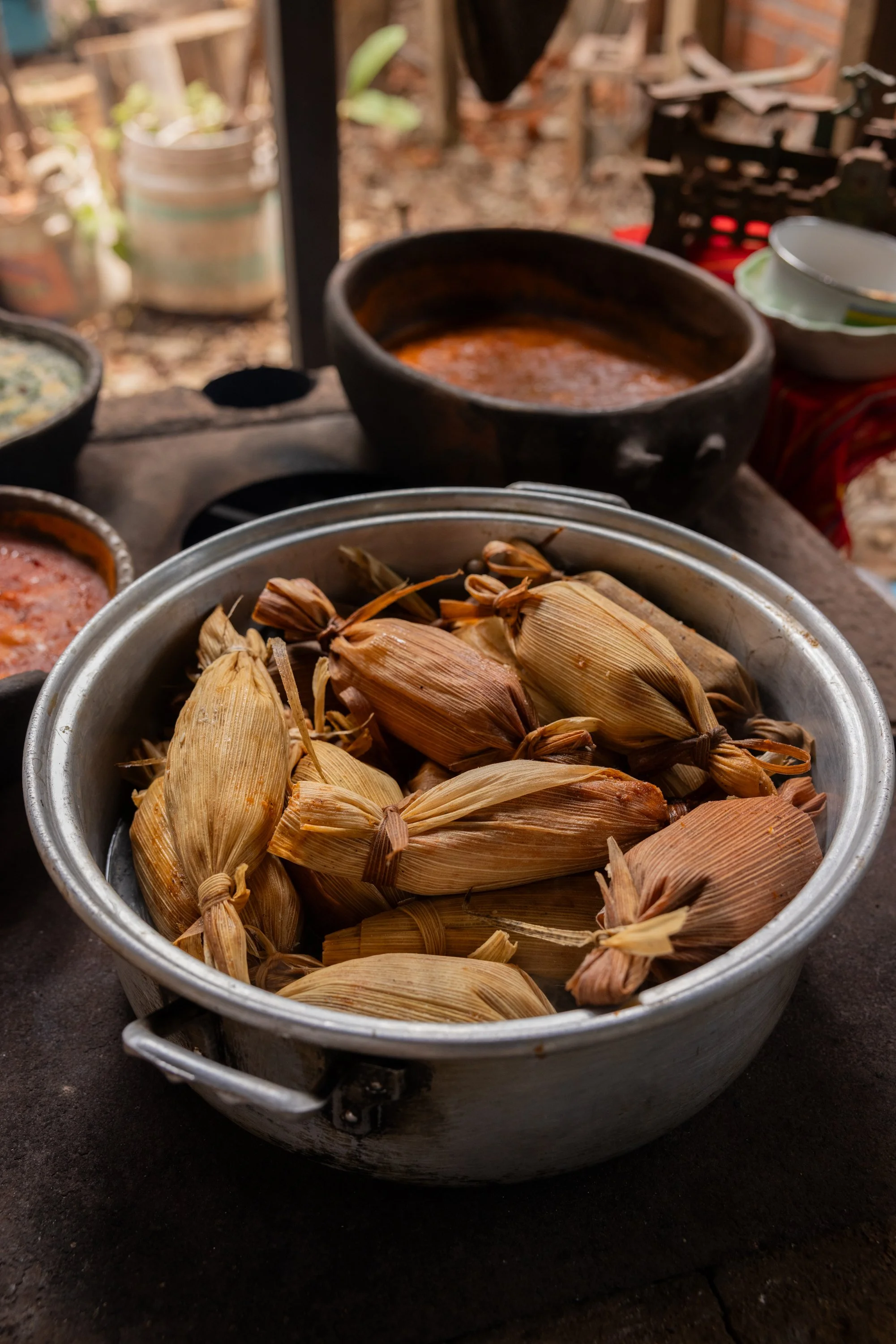Chiapas, Mexico: State of Uninterrupted History
A state rich in forest, art, farming, and traditional culture, Chiapas, the southernmost state in Mexico has been on my list of places to visit for many years. I had read that it was a place few tourists knew about, but was a destination for people seeking beautiful nature and history. As I often do when traveling to Mexico, I reached out to my friend, Paco who is my trusted guide throughout the country I love so much. A resident of Mexico City, Paco had never traveled to Chiapas, so he contacted his friend, José Bossuet Martinez, the private chef of the former president of Mexico. José is a native of Chiapas and an advocate of promoting tourism through his project, Chiapas Experiencias. He and his business partner, Rudy created a personized itinerary for me and my photographer, Valerie Wei-Haas. Paco made sure they knew that my priority was to learn about the culinary culture of the state, with a few other adventures added on.
It was important to understand the history of Chiapas, which José and Rudy were eager to share. There are more indigenous people in Chiapas than another state in Mexico. Mayans began to dominate the region in 300 AD and Aztecs appeared around the 15th century. The Spanish domination in the 16th century caused much division and tumultuous uprisings. Even today, there are many cultural isolations, as well as considerable isolation from the rest of Mexico. Even though Chiapas is rich in culture, farming, and landscape, they are the poorest state in the country.
We began our adventure in the capital city of Tuxtla where Rudy and José took us to the home of Florasita who taught us a cooking lesson in the courtyard that enclosed her kitchen. The gravel floor was damp from the rain, and we steadied ourselves on wooden chairs while Flora served us pozol, a drink of fermented corn and cocoa before explaining what we would cook. Her husband was busy adding wood logs to the fire that heated the clay oven and metal rack that held several cazuelas (clay pots). Soon, we were busy chopping onions to go into sopa de chipilín, a local soup made with chipilín leaves, an herb native to Chiapas. The base was a corn broth with little masa balls boiled into it like dumplings. We also made tamales with chunks of pork and adobo sauce, which cooked in a large pot covered in water, unlike other tamales that are steamed.
Another specialty of Tuxtla is chicatanas, which are huge black flying ants that appear during the rainy season during darkness. They are collected and dried until they are crispy and ready to eat either alone or in salsas or tamales. Flora was well-known in her neighborhood for selling chicatanas in bags by weight. We tried them on several occasions in Tuxtla and they weren’t too bad, as long as you didn’t consider they were flying ants!
On our final morning in Tuxtla we were invited to the home of Chef José and his parents. For breakfast we were served three kinds of tamales, each wrapped differently and filled with beans, cheese, chipilín, and pork. José explained the importance of tamales in the Mexican culture and the fact that there are hundreds of types of tamales in the country.
One of the tourist destinations near Tuxtla is the Sumidero Canyon, which is best viewed from a boat ride on the Grijalva River. We hired a private boat captain, and even though it was raining, we took a very wet ride to see the gorgeous views of the massive canyons peeking through the clouds. Even from under our tarp to protect us from the rain, we spotted a few crocodiles, vultures, pelicans, and spider monkeys.
Just outside the city of Ocosingo we visited Dorados del La Selva, a ranch where a family of five specializes in making queso bola, a cow milk cheese that is formed into a ball and then wrapped with hot cheese similar to mozzarella. The father, mother, and three grown sons led us to a picnic table where they served breakfast of quesadillas with chorizo and slices of queso bola, which was salty and delicious. After breakfast, Valerie and I each milked one of the cows and began the process of making cheese with the milk. Before we departed we watched the family perform a charerria horse show, which is a national Mexican sport. The father and three sons each demonstrated different techniques on their horses, and then insisted we all ride around the coral, making it the third time I’d ridden a horse in Mexico, and definitely the safest!
Our last four days in Chiapas were spent in the quaint town of San Cristóbal where we stayed at a lovely b&b called Guayaba Boutique Inn, a 200-year-old house that had been renovated into a small hotel. We didn’t spend a lot of time in the hotel since we were busy visiting nearby villages during the day.
My favorite excursion was to Chamula, a town unique to Chiapas for many reasons. It is home to the Tzotzil Mayan people who have preserved ancient customs and traditions, including their belief that sheep are sacred, never eating the meat, but only using their wool. We visited the home of Antolina, her mother, and sister, who raise sheep and weave their wool into the traditional garments of their village. The women wear heavy black skirts woven with black curly wool. The men wear heavy vests made with the same wool in white. The three women demonstrated how they comb the wool, spin it into yarn, and weave it on backstrap looms. I attempted to weave a few threads with the help of Antolina and it was very difficult. They also make beautiful colorful scarves and shawls, many of which I purchased to take home.
On the way back to San Cristobal we stopped in the city of Zinacantán, known as the “city of bats”. One of the main trades is growing flowers, and there are hundreds of greenhouses where exotic flowers are grown and shipped all over Mexico. The flower industry has had such a positive impact, the weavings in the local clothing often has flower motifs (as well as bats). The Church of San Lorenzo is particularly beautiful since the interior is covered in fresh flowers.
Another interesting excursion in Chiapas was a visit to Amatenango del Valle, an area known for its pottery since the nearby mountain is full of white clay perfect for ceramics. We spent the morning in the home of Felipe, where she and her family collect the clay and form it into beautiful bowls and sculptures, some as big as three feet high. They specialize in making sculptures of the jaguar, which is considered a sacred animal in Chiapas for its strength and bravery. I tried my hand at forming the clay into a little bowl while Paco made an ashtray. Felipe promised to finish our sculptures and send them to us with our other purchases from their gallery of pottery.
We explored San Cristobal in the evenings, even though it rained every night. But Valerie and I discovered some beautiful craft shops, coffee and chocolate shops, and marvelous restaurants. There are many ex-pats living in San Cristobal so there are also many cuisines represented in their restaurants. One night we at Thai food in a gorgeous food hall called Esquina San Agustin. There are two levels with coffee shops, chocolates, and international food.
On our last night in San Cristobal we dined at Tierre y Cielo, owned by Chef Marta Zepeda, a friend of Paco’s. It was in a beautiful building that was once her grandmother’s home. It was built in the 1700s and Marta had transformed it into a contemporary restaurant filled with local art and tropical plants. She served traditional Chiapas dishes in an artistic presentation, and it was delicious. Fortunately, the following morning we got to take a cooking lesson from Marta in her kitchen.
Marta put us all to work as we toasted chiles, and made asado chiapaneco, deeply caramelized pork dish rich in chiles, spices, and chocolate. Fiesta rice was also tasty, but learning to make triangle quesadillas (tetelas) with 3 different masas filled with cheese and ground pepitas was probably my favorite task of the day. For dessert we grilled local peaches, which were layered over a creamy custard scented with canela. For lunch we feasted on all the dishes we had made, and Marta toasted our visit with sips of pox, a traditional local drink made of distilled corn.
Chiapas proved to be everything I had expected and more. The beauty of the landscapes, the native artistry, indigenous food, and gracious people made it a very special place to visit. Valerie said she’d never taken so many beautiful photos in so few days. When I returned home I unpacked all my treasures, including dried chilies and cocoa nibs, which I quickly began grinding to make asado chiapaneco, the dish I’d learned from Marta. I still crave the sopa de chipilín we made with Florasita, and I’d give anything for a cup of pozol for breakfast. As soon as the weather gets cool I’ll begin wearing my woven scarves from Chamula, and I’ll use my pottery bowls with fond memories of Felipe and her family.
I owe a special thanks to Chef José and Rudy for showing us their home of Chiapas and all it has to offer. It is definitely a place where I would return, but next time I’ll take a bigger suitcase to bring home even more treasures!











































